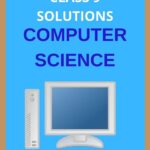Class 9 Computer Science Chapter 5 Ethics In it Question Answer, Computer Science Class 9 Solutions, NCERT Class 9 Computer Science Chapter 5 Ethics In it to each chapter is provided in the list so that you can easily browse throughout different chapters SCERT Class 9 Computer Science Chapter 5 Ethics In it and select needs one.
Class 9 Computer Science Chapter 5 Ethics In it
Also, you can read the SCERT book online in these sections Solutions by Expert Teachers as per SCERT (CBSE) Book guidelines. NCERT Solution of Class 9 Computer Science Chapter 5 Ethics In it is part of AHSEC All Subject Solutions. Here we have given Class 9 Computer Science Chapter 5 Ethics In it Notes for All Subjects, You can practice these here in SEBA Class 9 Computer Science.
Ethics In it
Chapter – 5
COMPUTER SCIENCE
TEXTUAL QUESTIONS AND ANSWERS
OBJECTIVE TYPE QUESTIONS
1. Fill in the blanks.
(a) Directly copying text, word for word is called ______.
Ans. Plagiarism.
(b) ______ refers to attempts to gain information from otherwise undisclosed areas.
Ans. Hacking.
(c) _______ refers to the unauthorised duplication of computer software.
Ans. Piracy.
2. Choose the correct option.
(a) C in ICT stands for _____.
(1) Communication
(2) Computer
(3) Control
(4) None of these
Ans. (1) Communication
(b) Making illegal copies of copyrighted software is called ____.
(1) Software piracy
(2) Browsing
(3) Collaboration
(4) Electronic distribution
Ans. (1) Software piracy.
(c) Purchasing of only one licensed copy of a software and distributing/loading it onto multiple systems is called as _____.
(1) Softlifting
(2) Renting
(3) Hard disk loading
(4) Patent
Ans. (3) Hard disk loading.
DESCRIPTIVE TYPE QUESTIONS
3. Short answer questions.
1. What are the main functions related to information?
Ans. The main functions related to information are :
(a) Collecting information.
(b) Storing information.
(c) Distributing information.
2. Define the term plagiarism.
Ans. Plagiarism means using someone else’s work without giving them proper credit. In academic writing, plagiarizing involves using words, ideas, or information from a source without citing it correctly.
3. Write down the major issues of security and integrity of information.
Ans. The major issues are as follows:
(a) Confidentiality.
(b) Integrity.
(c) Availability.
4. What is software piracy? What are its common forms?
Ans. Software piracy refers to unauthorised duplication of computer software. The most common forms of software piracy are Softlifting, unauthorised downloading and uploading, hard disk loading, software counterfeiting and illegal software renting.
5. Name three types of law that can help restrict software piracy.
Ans. The following are the three types of law that can help to restrict software piracy:
(a) Copyright.
(b) Patent.
(c) Trademark.
6. An extended synonym for Information Technology is ICT. So, how ICT differs from IT?
Ans. The difference between ICT and IT are:
| Sl. No. | ICT | IT |
| 1 | ICT stands for Information and Communications Technology. | IT stands for Information Technology. |
| 2 | Information and Communications Technology is associated with the field of education. | Information Technology is associated with the field of computers, software, networks, etc. |
| 3 | Information and Communications Technology is used in academic institutions and purposes. | Information Technology is used in corporate and other huge, complex companies and instructions. |
| 4 | It simply uses computer to store, retrieve, transmit and process data or information. | It simply transfers messages among people or machines using technology. |
| 5 | It helps business in several ways such as cut costs, improve communication, streamline communication, facilitate strategic thinking, eliminate wastes, etc. | It helps business in several ways such as make it easy to communicate with remote workers, fast method of communication during emergencies, one can communicate from anywhere in world, etc. |
7. IT security today has become a major point of concern. What comes under IT security?
Ans. IT security is a term that is more concerned with the protection of hardware, software and a network of an organization, from the perils of disaster and external attacks through virus, hacking etc.
8. Elaborate the term software ethics.
Ans. It includes methods to avoid violating the unauthorized distribution of digital content. The core issues surrounding computer ethics are based on the use of the internet, internet privacy, copyrighted content, software, and related services, and user interaction with websites.
9. Explain the need of protecting intellectual property right.
Ans. Intellectual property rights (IPR) refers to the legal rights given to the inventor or creator to protect his invention or creation for a certain period of time. These legal rights confer an exclusive right to the inventor/creator or his assignee to fully utilize his invention/creation for a given period of time.

Hi, I’m Dev Kirtonia, Founder & CEO of Dev Library. A website that provides all SCERT, NCERT 3 to 12, and BA, B.com, B.Sc, and Computer Science with Post Graduate Notes & Suggestions, Novel, eBooks, Biography, Quotes, Study Materials, and more.




What is counterfitting ( class 9 seba ) plz answer…..